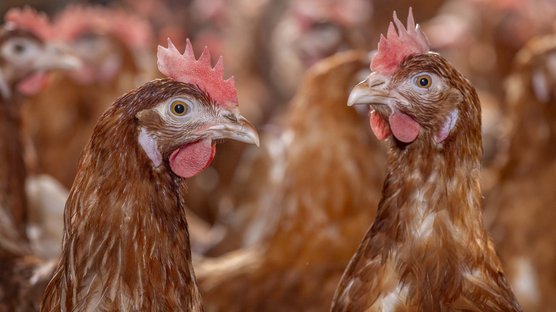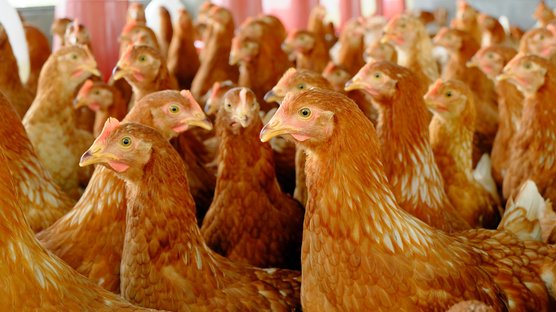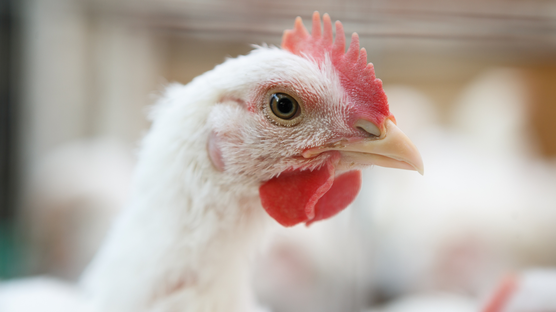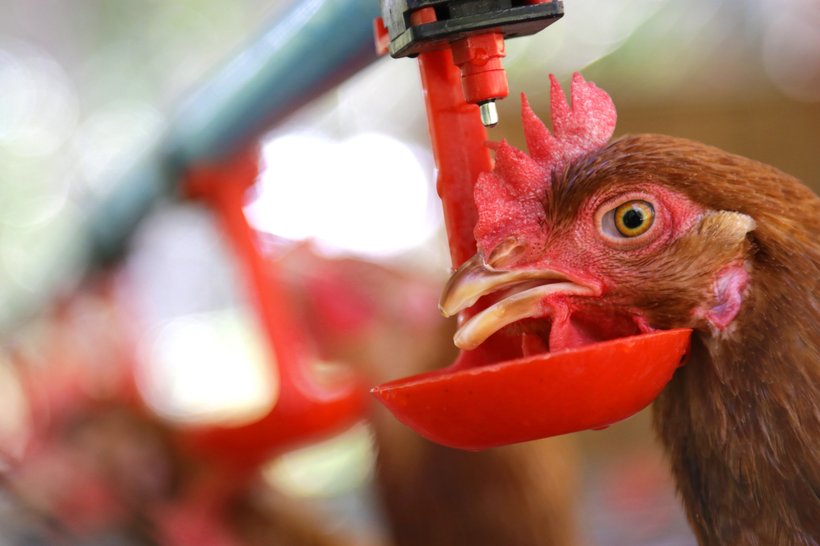
Published on May 29, 2024
Necrotic Enteritis in egg layers
The need to produce profitably continues to force us to implement changes that help us reduce the impact of production costs, to balance the additional cost of higher animal welfare, and improve the value of the final products for the consumer (eggs) and customer (day-old chicks). These changes need to be technically based, economically viable and operationally applicable.
Feed conversion remains a critical issue for all egg producers as 50-70% of production costs are linked to this the cost of feed. Poor feed conversion requires more birds to achieve equal egg volume and more feed to be purchased, stored, processed and delivered.
Since the 1960s, the damage caused by the gram+ bacterium Clostridium perfringens has been recognized as Necrotic Enteritis. This bacterium is recognized as being one of the most prevalent in industrial poultry environments. The toxins produced by Clostridium are the main cause related to problems in poultry. The spores of C. perfringens can even withstand temperatures of 100oC for 60 minutes in the environment, making it difficult to eradicate the bacteria. These characteristics (spores and toxins) are also found in Clostridium botulinum, which causes botulism.
In young chickens, for example in the rearing phase, this acute prevalence of necrotic enteritis causes flock mortality (up to 30%). Prior to mortality, it can cause lower weight gain already from the first weeks of age and be associated with performance losses in the production phase. The lesions caused to the gastrointestinal tract generate these direct consequences and other indirect ones, such as lower feed conversion, fluctuations in production and egg quality.
The clinical symptoms include: feather ruffling and scruffiness of the birds, erosion of the gizzard, hemorrhagic/necrotic spots along the small intestine (mainly jejunum and ileum), and loss of intestinal motility, (with accumulation of gases and liquids, causing a "sausage" appearance and a foul smell to its contents. A clear finding on postmortem to indicate that you are dealing with Necrotic Enteritis is the pseudo membrane present focally or diffuse in the intestine. The pseudo membrane consists of dead cells, bacteria and inflammatory proteins secreted by the intestine, and it is where the name Necrotic Enteritis comes from. Please note that hepatomegaly with hemorrhagic or whitish spots is also associated with the presence of C. perfringens, but this is not direct related to Necrotic Enteritis.
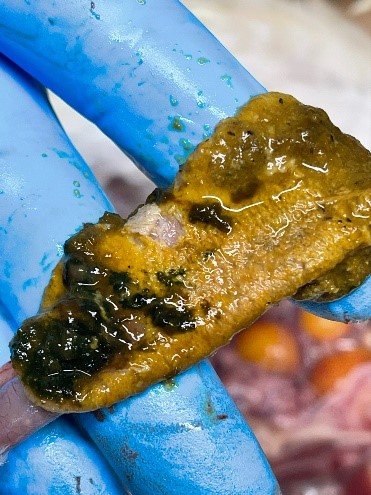
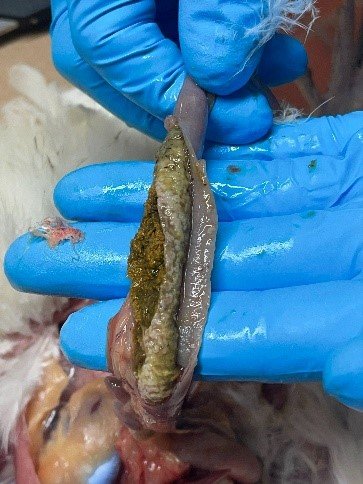
When visiting your flocks, look out for spots of frothy, mustard-colored droppings, droppings with mucus (in the aviary litter and on the manure mats) and uneven pigmentation of the hens feet and beaks. During necropsies, note the accumulation of gases in the intestines and the presence of unabsorbed xanthophylls ("tomato spots"). And in the egg-breaking room, assess the uniformity of the color of the yolks. All these signs serve as a warning of possible problems that may already be affecting the flock's intestinal health.
From a sanitary point of view: coccidiosis has proven to be a "great partner" for Clostridium. The cellular lesions caused by Eimeria, which result in increased mucus production and a reduction in the digestibility and absorption rate of nutrients present in the intestinal lumen, are factors that create a favorable intestinal environment for worsening conditions. Controlling coccidiosis through vaccination has proved effective, but care must be taken to monitor and control possible vaccine reactions. Always consult your local veterinarian and ask for guidance and advice.
From a management point of view: longer contact with feces, either in cage-free birds through contact with poultry litter, or in caged birds through residual manure in the facilities, also favors contamination with Clostridium. Monitor feed and water consumption and check that the feeders and drinkers are working properly. Restricting water and food for long periods (more than 24 hours) can destabilize the intestinal flora and encourage Clostridium (and other undesirable microorganisms) to multiply. Thorough cleaning and disinfection between rearing and production cycles will help to lower the pressure.
From a nutritional point of view, factors such as mycotoxins, excess protein in poultry diets and using feed ingredients with low digestibility have been shown to be potentiating factors for this problem. Diets based on wheat, barley and rye and/or with high concentrations of ingredients of animal by-products (such as meat and bone meal, fish meal) or ingredients with a lower digestibility (such as rapeseed meal) have also been linked to the incidence of necrotic enteritis. Sudden changes in formulation (e.g. the need to change formulation due to the introduction or discontinuation of an ingredient) also serve as "triggers" due to dysbacteriosis resulting from these changes.
From an medication point of view: the drug options available on the market are becoming increasingly limited. Therefore it is key to focus on controlling this disease through joint action on different fronts:
- Health: Keep coccidiosis under control, carry out vaccination management according to the recommendations of the vaccine suppliers and use additives that help control any exacerbated vaccine reactions. Pay attention to the first clinical signs and changes in the feces. Only medicate during clinical cases (via drinking water is the most suitable because of the drop in feed consumption), under the guidance of the veterinarian in charge and following the local legislation. It is important to respond quickly to these problems in order to minimize the consequences.
- Management: Promote the empty feeder technique to avoid the accumulation of old feed in the feeders and any other factor that causes excessive dirt in the rearing environment.
- Nutrition: Different products available for use can be combined to help protect the birds' intestinal integrity: Probiotics (there are strains available on the market aimed at controlling clostridiosis, such as Bacillus lincheniformis and Bacillus amyloliquefaciens); Organic acids: such as butyric acid and its combinations with glycerides; Essential oils. New products are appearing on the market all the time, and the solution to a specific/regional problem can be obtained by combining certain products. Correct dosage procedures in the feed and monitoring the birds' performance are important factors in finding the best solution.
In addition:
- Using insoluble fibers and enzymes helps to reduce the viscosity of the intestinal contents;
- Neutralizing mycotoxins with products that reduce the absorption of mycotoxins (adsorbents and enzymes), thereby reducing the risk of problems with the digestibility of ingredients;
- Monitor the flock weight gain and uniformity weekly till 30 weeks and monthly afterwards and reduce the environmental and sanitary factors that hinder weight gain to avoid the prolonged use of highly concentrated feed during the rearing phase;
- Stimulate the development of the gizzard's capacity for ingestion and musculature through appropriate feed granulometry so that the gizzard can process the ingested feed and reduce the availability of unprocessed nutrients in the gastrointestinal tract;
- Avoid excessive use of medication in the flocks, instead find a solution to the problems that lead to the use of medication.
Breeding and egg production conditions change, the nutritional value and availability of ingredients change, and the microorganisms present in the industrial poultry environment also change. It is therefore important to take a broad, systemic view so that the most assertive solutions can be adopted to keep the pathogens and so Necrotic Enteritis under control at your poultry farms.
References:
- Avian Disease Manual (7th Edition 2013): https://aaap.memberclicks.net/avian-disease-manual-old-edition#calibre_link-844
- Necrotic enteritis: Necrotic enteritis (dsm.com)
- Necrotic enteritis in poultry: https://www.msdvetmanual.com/poultry/necrotic-enteritis/necrotic-enteritis-in-poultry
- Doença das aves (Livro): 3a. Edição (2020). Fundação APINCO de Ciência e Tecnologia Avícolas

